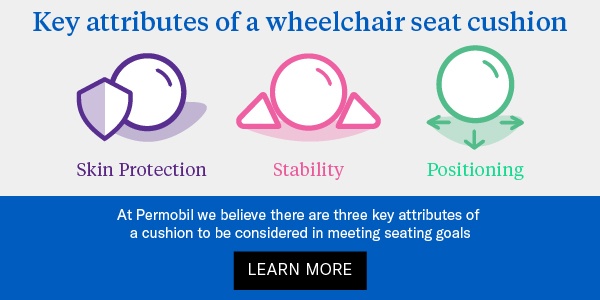There are a few misconceptions that seem to persist in the world of wheelchair seating and positioning. Last week we looked at the wedge misconception, and we're now taking a look why a patient could be sliding out of the wheelchair and some possible solutions.
What should I do when my patient keeps sliding out of the wheelchair?
First, we need to find out why they are sliding. The list below can help get you started.
- Check for tightened hamstrings as they can pull the pelvis forward in the seated posture
- Check for hip ROM and see if they are trying to increase the seat-to-back angle by sliding forward
- Check the seat depth and see if it is too deep and putting pressure on the back of their legs
- Check the seat-to-floor height, and see if they are sliding to try and reach the floor for propulsion
- Check trunk stability and strength. If weakness is present, the patient may slide forward seeking stability
When we know what might be causing the patient to slide, then we can look at possible solutions.
- Accommodate tightened hamstrings by adapting the seat depth and back angle to match the patient’s posture. Use an immersion style cushion to protect the sacrum and coccyx from pressure injury
- Adjust the seat-to-back angle either through the back canes or the hardware of the back support. Find their optimal STBA based on your mat evaluation results
- Measure upper leg length and get a wheelchair with the appropriate seat depth
- Lower STFH at the wheel axle or use a drop seat
- Try a cushion with tapered adductors that will stabilize the pelvis and provide increased support for the trunk
To learn more about seating and positioning, check out the digital wheelchair seating and positioning. To see the rest of the Permobil education guides click here.

 Stacey Mullis, OTR/ATP
Stacey Mullis, OTR/ATP
Director of Clinical Marketing
Stacey serves as Director of Clinical Marketing for Permobil. A practicing OTR for over 20 years, she has experience in school-based pediatrics, inpatient rehabilitation, long term care, and home health. With her interest in wheelchair seating and positioning, Stacey engaged the challenges of providing appropriate seating in various clinical settings. She now uses this experience to develop programs and resources to educate clinicians on the principles of seating and wheeled mobility. She is passionate about equipping clinicians and through her previous role as Director of Clinical Education with Comfort Company and now with Permobil she has taught nationally and internationally to increase therapist capacity in this specialty area. Mullis graduated from Western University in London, Ontario, Canada with a BA Linguistics and BSc Occupational Therapy. She is a member of the NCOTA, CTF Executive Board, NRRTs, RESNA, and AOTA.

